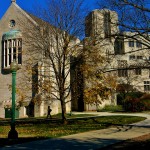When Elsie Meyers graduated from Wolcottville High School in rural northeastern Indiana in 1940, she never dreamed that she’d become an anesthesiologist.
Meyers’ ambition was to attend Ball State Teacher’s College and become a teacher of nurses, but a lack of funds meant she had to work for three years as an assistant in a doctor’s office instead. She soon became much more than an office worker, assisting with a number of deliveries and learning all the while about the practice of medicine.
Improper conduct by the doctors gave Meyers the motivation she needed to leave La Grange and attend pre-med courses at IU in Bloomington.
Meyers succeeded in college, graduating after only three years, and then faced the challenge of getting into medical school in 1947. During the 1940s, women made up fewer than 10% of American medical school graduates. There were thirteen applicants for each open spot at IU’s medical school—World War II had ended, and many eligible applicants funded by the G.I. Bill competed with Meyers for those coveted spots.
But Meyers was admitted, and she was part of the first class at the new medical school in Indianapolis.
At first, Meyers and other female students were either ignored or made the target of jokes:
The girls in the class were completely ignored. The class was addressed as ‘You men’ or ‘You boys.’ [The anatomy professor] told raunchy jokes, most of which I didn’t understand. Then everyone would look at us girls to observe our reaction.
Meyers worked hard and studied long and won the respect of her teachers; she particularly enjoyed her clinical rotations. She treated polio patients at Riley Children’s Hospital, spent time at the state hospital for the criminally insane, and worked delivering babies at homes in the city’s poorest neighborhoods, where she witnessed many dramatic scenes. She was also able to draw on her pre-college experiences:
One night, I was on call with an intern who considered all medical students to be dirt under his feet. There was a patient in labor who was making rapid progress. I asked the nurse to call him, but he refused to come, thinking that the medical student didn’t know anything, and that he knew everything. The nurse and I got her to the delivery room and I sent another message: “Doctor, are you coming? If not, shall I deliver the baby?” This time he came, arriving in the nick of time.
Meyers graduated from medical school with honors and moved to Philadelphia for an internship in anesthesiology at the University of Pennsylvania. By this point, Meyers had already been on quite a journey, starting from a rural, economically disadvantaged background and making it all the way to an internship in one of the nation’s largest cities.
A Moment of Indiana History is a production of WFIU Public Radio in partnership with the Indiana Public Broadcasting Stations. Research support comes from Indiana Magazine of History published by the Indiana University Department of History.
Sources: Indiana Magazine of History 104, no. 4 (Dec. 2008): Elsie F. Meyers, “Doing the ‘Not Possible’: The Memoirs of Elsie F. Meyers, M.D.”, pp. 329-366; and Alexandra Minna Stern: “Against the Odds: Becoming a Female Physician in Midcentury Indiana,” pp. 323-238.






















